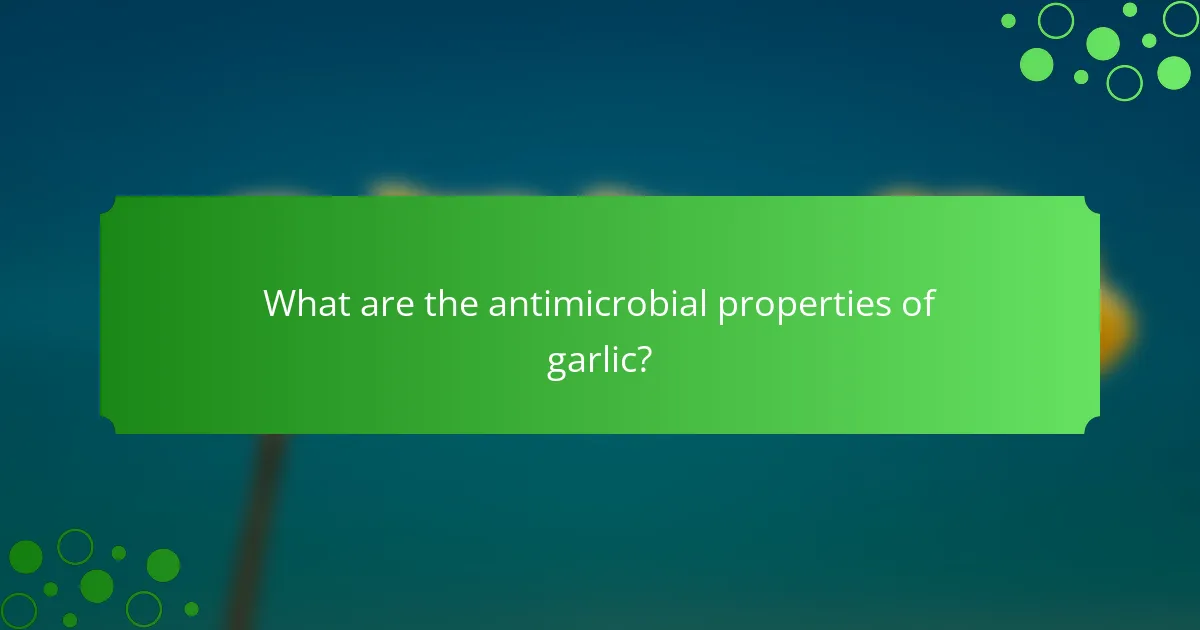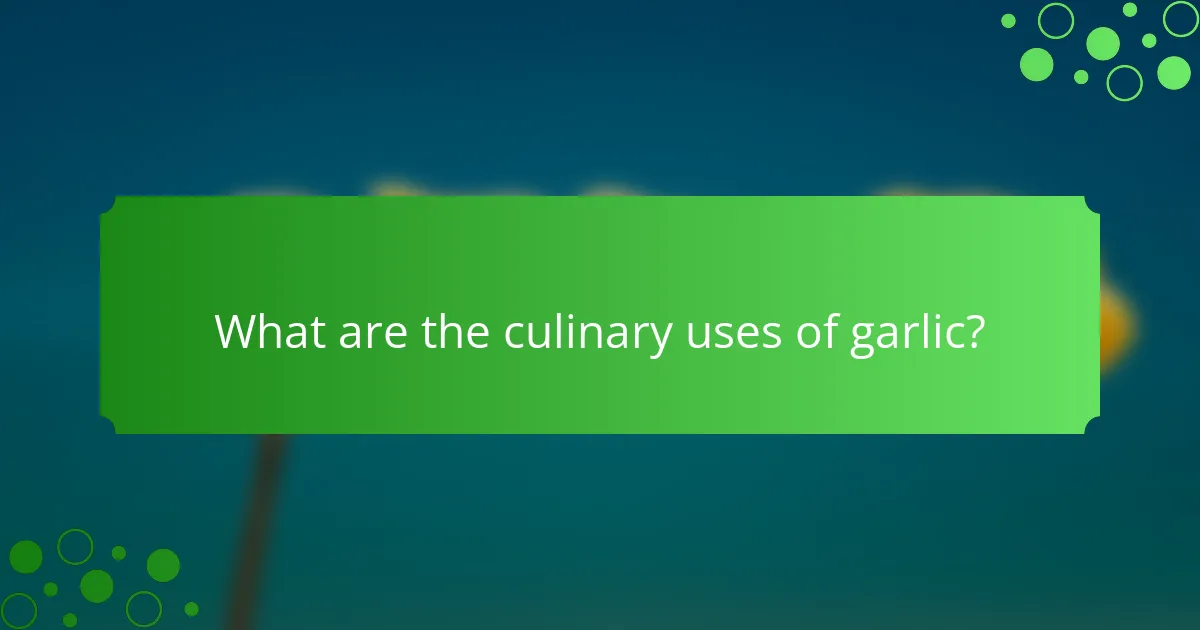Garlic is renowned for its strong antimicrobial properties, making it a powerful ally in promoting health. This article explores garlic’s ability to combat infections, enhance immune function, and support cardiovascular health. Additionally, it highlights various culinary uses and forms of garlic, providing practical tips for storage and consumption. Understanding these aspects can help maximize the benefits of this versatile ingredient.

What are the antimicrobial properties of garlic?
Garlic possesses strong antimicrobial properties, effectively combating various bacteria, viruses, and fungi. Its active compound, allicin, contributes significantly to these effects. Studies demonstrate garlic’s ability to inhibit pathogens like E. coli and Salmonella. Additionally, garlic enhances immune function, further supporting overall health.
How does garlic combat bacteria and viruses?
Garlic effectively combats bacteria and viruses due to its active compounds like allicin. Allicin exhibits strong antimicrobial properties, disrupting the cellular processes of pathogens. Studies show that garlic can inhibit the growth of various bacteria, including E. coli and Salmonella, and may enhance immune function. Regular consumption of garlic can contribute to overall health by reducing the risk of infections.
Which compounds in garlic contribute to its antimicrobial effects?
The main compounds in garlic that contribute to its antimicrobial effects include allicin, ajoene, and thiosulfinate. Allicin, formed when garlic is crushed, exhibits strong antibacterial and antifungal properties. Ajoene enhances these effects and has been shown to inhibit the growth of various pathogens. Thiosulfinate compounds also play a role in garlic’s overall antimicrobial action, making it effective against a range of microorganisms.
What research supports garlic’s antimicrobial benefits?
Research shows that garlic exhibits significant antimicrobial benefits, supported by various studies. For instance, allicin, a compound found in garlic, has demonstrated effectiveness against bacteria, viruses, and fungi. A study published in the Journal of Antimicrobial Chemotherapy found that garlic extracts inhibited the growth of several pathogenic bacteria, including E. coli and Salmonella. Additionally, a review in the Journal of Nutrition highlighted garlic’s ability to enhance immune function, further contributing to its antimicrobial properties. Garlic’s unique ability to combat antibiotic-resistant strains of bacteria is also noteworthy, making it a valuable natural remedy in modern health practices.

How does garlic benefit overall health?
Garlic significantly benefits overall health by providing antimicrobial properties, enhancing immune function, and improving cardiovascular health. Its active compounds, such as allicin, help combat infections and reduce blood pressure. Regular consumption can lower cholesterol levels and support heart health. Additionally, garlic’s antioxidant properties contribute to reducing inflammation and protecting against chronic diseases.
What are the cardiovascular benefits of garlic?
Garlic offers significant cardiovascular benefits, including lowering blood pressure and reducing cholesterol levels. It contains allicin, which improves blood circulation. Studies show garlic can decrease the risk of heart disease by enhancing arterial health. Regular consumption may also prevent plaque buildup in arteries.
How does garlic support immune function?
Garlic significantly enhances immune function through its antimicrobial properties. It contains compounds like allicin, which exhibit antibacterial and antiviral effects. Studies indicate that regular garlic consumption can reduce the severity and duration of colds. Additionally, garlic may stimulate the activity of immune cells, improving the body’s response to infections. Its unique attribute lies in its ability to boost the immune system while also providing cardiovascular benefits.
Which studies highlight garlic’s cancer-fighting properties?
Several studies highlight garlic’s cancer-fighting properties, particularly its ability to inhibit tumor growth. Research indicates that compounds in garlic, like allicin, exhibit antioxidant effects, which may reduce cancer risk. A meta-analysis published in the Journal of Nutrition found that high garlic intake is associated with a lower risk of certain cancers, including stomach and colorectal cancers. Additionally, laboratory studies have shown that garlic extract can induce apoptosis in cancer cells, further supporting its potential as a natural cancer-fighting agent.
What are the digestive health benefits of garlic?
Garlic supports digestive health by promoting gut flora balance and providing antimicrobial effects. Its prebiotic properties enhance beneficial bacteria, improving digestion and nutrient absorption. Additionally, garlic may help reduce inflammation in the gut, contributing to overall digestive wellness.

What are the culinary uses of garlic?
Garlic is versatile in culinary applications, enhancing flavor and providing health benefits. It is used in various forms, including raw, roasted, and powdered. Garlic adds depth to dishes like sauces, marinades, soups, and stir-fries. Its antimicrobial properties contribute to food preservation, making it a valuable ingredient in many cuisines. Additionally, garlic complements meats, vegetables, and grains, enriching meals with its distinctive taste.
How can garlic be incorporated into various cuisines?
Garlic can be incorporated into various cuisines through roasting, sautéing, or as a raw ingredient. It enhances flavors in Mediterranean dishes like pasta and sauces, adds depth to Asian stir-fries, and is essential in Indian curries. Roasted garlic can be spread on bread, while minced garlic is often used in dressings and marinades. Its antimicrobial properties also make it a healthy addition to meals, promoting overall wellness.
What are popular garlic recipes from different cultures?
Garlic is used in various cultures, showcasing diverse culinary applications. Popular garlic recipes include:
1. Italian Aglio e Olio: Spaghetti tossed with garlic, olive oil, and chili flakes.
2. Chinese Garlic Chicken: Stir-fried chicken with garlic, soy sauce, and vegetables.
3. Indian Garlic Naan: Leavened bread infused with garlic, baked in a tandoor.
4. Spanish Garlic Shrimp: Shrimp sautéed in garlic-infused olive oil with paprika.
5. Middle Eastern Garlic Sauce: A creamy dip made with garlic, lemon, and oil.
6. French Garlic Soup: A broth-based soup featuring roasted garlic and herbs.
How should garlic be prepared for maximum flavor and health benefits?
To maximize flavor and health benefits, garlic should be crushed or chopped and allowed to sit for 10-15 minutes before cooking. This process activates allicin, the compound responsible for garlic’s antimicrobial properties and health benefits. Cooking garlic at lower temperatures preserves its beneficial compounds while enhancing its flavor. Roasting garlic can also create a sweeter, milder taste. For raw consumption, adding it to salads or dressings retains its potent health benefits.

What are the different forms of garlic available?
Garlic is available in several forms, including fresh, dried, powdered, and oil. Fresh garlic offers the strongest flavor and health benefits, while dried garlic is convenient for storage. Garlic powder provides a concentrated flavor, and garlic oil is used for cooking and health applications. Each form retains varying levels of garlic’s antimicrobial properties and health benefits, making them versatile for culinary uses.
Which types of garlic are most commonly used in cooking?
The most commonly used types of garlic in cooking are hardneck, softneck, and elephant garlic. Hardneck garlic offers robust flavor and easy-to-peel cloves, making it popular for roasting. Softneck garlic, known for its long shelf life, is often found in grocery stores and is ideal for braiding. Elephant garlic, while technically a leek, has a mild flavor and large cloves, making it suitable for various dishes. Each type brings unique culinary benefits and enhances flavors in diverse cuisines.
What are the differences between fresh, dried, and powdered garlic?
Fresh, dried, and powdered garlic differ in flavor intensity, antimicrobial properties, and culinary applications. Fresh garlic has a strong, pungent flavor and retains higher levels of beneficial compounds. Dried garlic offers a milder taste and longer shelf life, while powdered garlic provides convenience and concentrated flavor. Each form can enhance dishes but varies in potency and health benefits.

What precautions should be taken when consuming garlic?
When consuming garlic, it is essential to consider potential precautions to maximize benefits and minimize risks. First, individuals with certain medical conditions, such as bleeding disorders or those on anticoagulant medications, should consult a healthcare provider before increasing garlic intake. Second, excessive consumption can lead to gastrointestinal discomfort, including bloating and gas. Third, pregnant or breastfeeding women should moderate their intake, as high amounts may not be safe. Lastly, garlic can interact with some medications, so awareness of these interactions is crucial for safe consumption.
Are there any side effects associated with garlic consumption?
Garlic consumption can lead to side effects such as gastrointestinal upset, bad breath, and allergic reactions. These effects vary based on individual tolerance and the amount consumed.
Common side effects include nausea, heartburn, and diarrhea, especially when consumed in large quantities. Some individuals may experience allergic reactions, which can manifest as skin rashes or respiratory issues.
Garlic’s unique attribute is its sulfur compounds, which contribute to both its health benefits and potential side effects. Moderation is key to minimizing adverse reactions while enjoying garlic’s antimicrobial properties and health benefits.
How does garlic interact with medications?
Garlic can interact with medications, potentially altering their effectiveness. It may enhance or inhibit drug metabolism, especially anticoagulants and certain HIV medications. This is due to garlic’s unique compounds, such as allicin, which can affect liver enzymes responsible for drug processing. Always consult a healthcare professional before combining garlic with any medication.

What are the best practices for storing garlic?
Store garlic in a cool, dark, and dry place for optimal freshness. Use a mesh bag or a basket to allow airflow, preventing mold. Avoid refrigeration as it can promote sprouting. Whole bulbs can last several weeks, while peeled cloves should be used within 10 days.
How long can garlic be stored while maintaining its properties?
Garlic can be stored for about three to six months while maintaining its properties. Proper storage conditions, such as a cool, dry place away from sunlight, help preserve its antimicrobial properties and health benefits. Whole bulbs last longer than peeled or chopped garlic, which should be used within a week when refrigerated.
What is the best way to preserve garlic for future use?
The best way to preserve garlic is by freezing, drying, or storing it in oil. Freezing retains its antimicrobial properties and flavor. To freeze, peel and chop garlic, then place it in an airtight container. Drying garlic involves slicing and using a dehydrator, which concentrates its health benefits. Storing garlic in oil requires caution due to botulism risk; ensure to refrigerate and use within a week. Each method effectively extends garlic’s culinary uses while maintaining its unique attributes.
What common mistakes should be avoided when using garlic?
Common mistakes to avoid when using garlic include overconsumption, which can lead to digestive issues, and using it in excessive heat, which diminishes its antimicrobial properties. Not allowing garlic to rest after chopping can also reduce its health benefits. Additionally, neglecting to store garlic properly can lead to loss of flavor and potency.